The fortification of Palmanova has a unique structure as it offers the visitor an insight into the innovations that the science of fortification has thought up over the centuries.
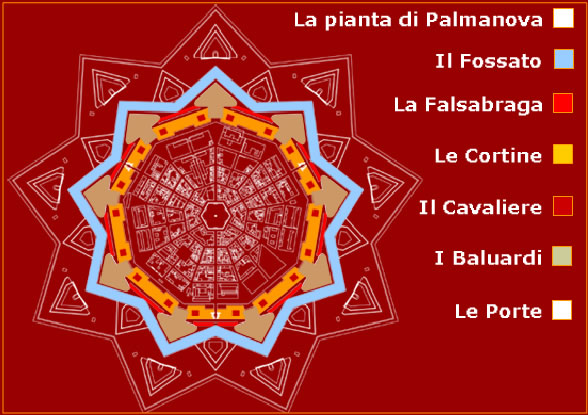 1st set of Walls (1593 - 1620) The Venetians built here low, wide embankments needed to defend the town by the artillery in the late XVI century.
1st set of Walls (1593 - 1620) The Venetians built here low, wide embankments needed to defend the town by the artillery in the late XVI century.  2 set of Walls (1665 - 1683) In the middle of the 17th century the Serenissima Republic of Venice thought the time had come to reinforce the stronghold (fortress fortified town), building nine new bastions (ravelins) beside the moat, on the straight side of the set of walls which surrounded the built-up area.
2 set of Walls (1665 - 1683) In the middle of the 17th century the Serenissima Republic of Venice thought the time had come to reinforce the stronghold (fortress fortified town), building nine new bastions (ravelins) beside the moat, on the straight side of the set of walls which surrounded the built-up area.  3th set of Walls (1806 - 1809) In 1806 Napoleon Bonaparte decided to renew the Palmanova "war machine", the most noticeable signs of which were the nine lunettes , that is, the bastions bounded by a dry moat.
3th set of Walls (1806 - 1809) In 1806 Napoleon Bonaparte decided to renew the Palmanova "war machine", the most noticeable signs of which were the nine lunettes , that is, the bastions bounded by a dry moat. 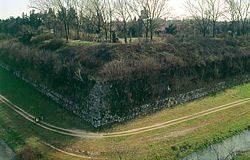 Rampart or Bastion : a wide arrow-shaped bank of earth enclosed in a stone or brick wall. There are nine ramparts making up a section of the walls surrounding the town, which in turn, are surrounded by a moat.
Rampart or Bastion : a wide arrow-shaped bank of earth enclosed in a stone or brick wall. There are nine ramparts making up a section of the walls surrounding the town, which in turn, are surrounded by a moat.
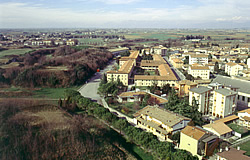 Cavaliere : a higher bank of earth at the end of each curtain. There are two of these to each Curtain – 18 in all, each offering extensive views over the surrounding countryside.
Cavaliere : a higher bank of earth at the end of each curtain. There are two of these to each Curtain – 18 in all, each offering extensive views over the surrounding countryside.
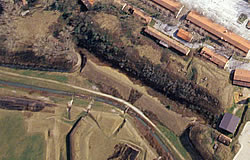 Cortina or Curtain : a straight bank of earth, with a stone or brick wall, linking two ramparts. In the middle of three of the curtains there are the three entrances or doors into the town: the Porta Cividale, Porta Udine and Porta Marittima (now known as Porta Aquileia). There are nine curtains forming the polygon of the fortress.
Cortina or Curtain : a straight bank of earth, with a stone or brick wall, linking two ramparts. In the middle of three of the curtains there are the three entrances or doors into the town: the Porta Cividale, Porta Udine and Porta Marittima (now known as Porta Aquileia). There are nine curtains forming the polygon of the fortress.
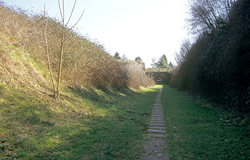 Falsabraga: a straight bank of earth positioned on a line parallel to the curtain at the level of the moat. Each has a short tunnel permitting it to be crossed in the middle. There are 9 falsabragas.
Falsabraga: a straight bank of earth positioned on a line parallel to the curtain at the level of the moat. Each has a short tunnel permitting it to be crossed in the middle. There are 9 falsabragas.
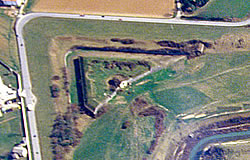 Lunette: a triangular embankment surrounded by a stone or brick wall with a casement (window ?) in the middle.
They are bounded by a dry moat and situated towards the countryside on the same line as the ramparts. There are two small field fortifications to protect the lunettes.
There nine lunettes in all.
Lunette: a triangular embankment surrounded by a stone or brick wall with a casement (window ?) in the middle.
They are bounded by a dry moat and situated towards the countryside on the same line as the ramparts. There are two small field fortifications to protect the lunettes.
There nine lunettes in all.
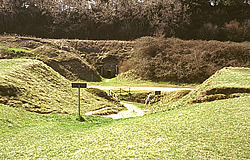 Rivellino: a triangular bank of earth surrounded by either a stone or brick wall and bounded by a dry moat. These are situated at the level of the surrounding countryside, beyond the moat to protect the single curtains. There are 9 rivelines.
Rivellino: a triangular bank of earth surrounded by either a stone or brick wall and bounded by a dry moat. These are situated at the level of the surrounding countryside, beyond the moat to protect the single curtains. There are 9 rivelines.
It is an outwardly structure similar to a gate and sometimes placed in a more visible position than the true one. It had to draw the enemies’ attention, who were tempted to conquer the entrance in order to penetrate the main building of the fortress. The false gate led, instead, to mortal traps. In Palmanova we could find false gates in every rivellino and lunette ( with two gates for each structure; there were 36 accesses to the town, among them only 3 were “true gates" which allowed to enter the fortress) Unfortunately almost all these false gates have disappeared in Palmanova.
It is an exit from the main body of the fortress, hidden both to the view and to the attackers’ shots. (It was used to move men and arms inside an outside the fortified fences with a full protection).
It was a perfectly smooth facing of the wall and the defensive structures, as well, made of stones. (It made climbing really difficult and besides, it captured the filling soil, used as a defence of the building, to drop the coming shots). It was not visible by the attacker who always stood in front of the low earthwork, therefore it didn’t give any idea of the complexity of the lower defensive structure.
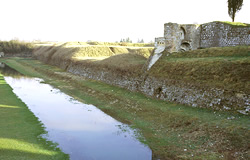 Wet or dry. In Palmanova we find both systems: the wet ditch was outside the first defensive walls; the dry ditch was beyond the other walls (such as rivellinos and lunettes). It was used to avoid the attackers’ rapid approaching the defensive structures.
Wet or dry. In Palmanova we find both systems: the wet ditch was outside the first defensive walls; the dry ditch was beyond the other walls (such as rivellinos and lunettes). It was used to avoid the attackers’ rapid approaching the defensive structures.
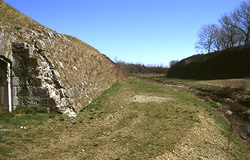 It was the fortress wall near the ditch (usually smoothly paved to stop the attackers’ climbing); opposite the ditch there was the counter-scarp, paved as well.
It was the fortress wall near the ditch (usually smoothly paved to stop the attackers’ climbing); opposite the ditch there was the counter-scarp, paved as well.
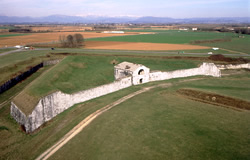 (of Napoleonic origin)
It was built at the base of the bulwark and acted as the last “stop" against those aggressors, who could come up to that point. ( In Palmanova only a few bulwark are fitted with them). It is interesting to note that the stables are here on the first floor to allow the chivalry to go out directly onto the esplanade of the bulwark.
(of Napoleonic origin)
It was built at the base of the bulwark and acted as the last “stop" against those aggressors, who could come up to that point. ( In Palmanova only a few bulwark are fitted with them). It is interesting to note that the stables are here on the first floor to allow the chivalry to go out directly onto the esplanade of the bulwark.
They are artillery posts set behind the “ear" of the bulwark, they run parallel to the curtain and are not visible by the enemy. They were used to “beat" with a “volley of blows" the esplanade between the “falsabraga" and the curtain, and made a mortal trap for those attackers who could penetrate the defences up to that point.
(of Venetian origin).
In Palmanova there are two loggias for each bulwark and were used as a "Guardhouse".
From the inside part of the left Loggia of each bulwark you can reach the "sortie" with a covered flight of stairs, derived from the thickness of the wall, used by infantry and artillery carrying firearms, and the chivalry on horses.
A small fortified redoubt, scarcely visible, used by the fusiliers (carrying light firearms). It was built as a defence of the particular passages and the “dry ditches” of the fortress (in Palmanova there are some near the gates and near the lunettes, but they are generally severely damaged).
Earthworks that “broke” the inner esplanade of the bastion in parallel with the “capital line”, used to stop the cannonades crosswise with a drop shot (the more dangerous); a technique developed later by Vauban (known as “tir a ricochet”), which made the cannon ball rebound, repeatedly, on the rampart, laming men and animals and destroying and damaging what was found around. Oddly in Palmanova there aren’t any but you can find them in every later polygonal fortresses. We hardly understand why Napoleon 1st didn’t build any of them. Even the lunettes he built, lack of this basic defensive structure which disappeared from the fortification techniques at the end of 19th Century.
A skid-shaped earthwork with an outer slight slope with a well designed step on the inner part. It is built in front of any type of fortified buildings. It was a protection from the shooting of the fusiliers and the artillery (who leant very little outside from it but allowed them to see the enemy).